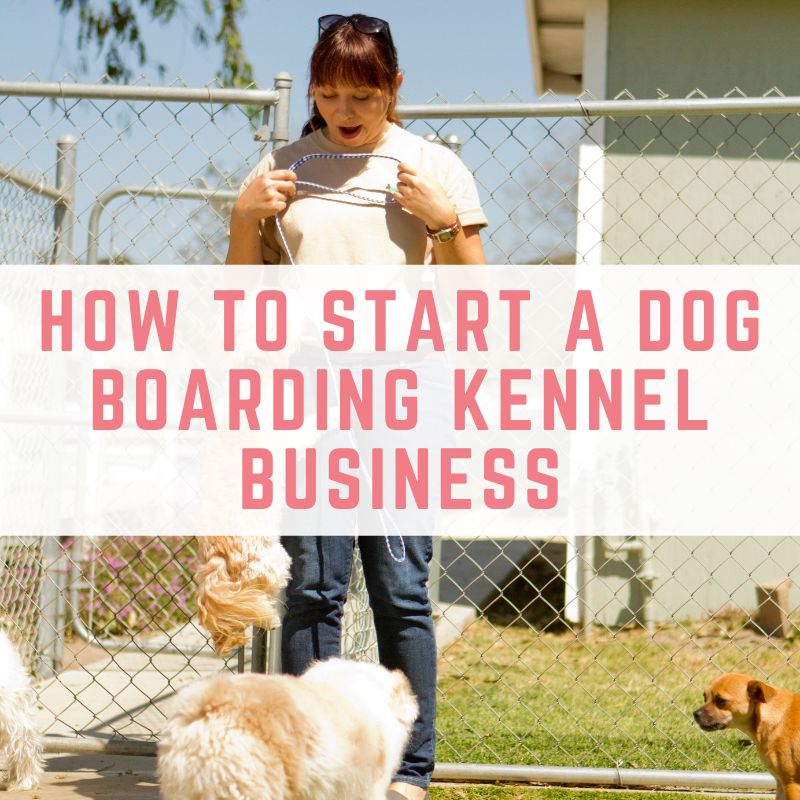If you love dogs and you have been looking for a business idea that combines your love for dogs and wanting to make extra money then you may have considered starting a dog kennel business. Starting a dog kennel business is a fantastic opportunity to combine a love for animals with an entrepreneurial venture. With the growing pet industry, and the increasing number of dog owners looking for reliable boarding and day care facilities, now is a great time to dive into this market. But, like any business, starting a dog boarding facility requires careful planning, dedication, and a deep understanding of what it takes to provide exceptional care for pets. While affection for dogs can provide a strong foundation for your business, it’s essential to recognize that running a dog kennel is a multifaceted endeavor that requires a range of skills and considerations. In this comprehensive guide, we'll walk through the essential steps needed to get your kennel business off the ground and make it a success in the long run.

Conduct Thorough Market Research
The first step in starting any business, especially a dog kennel business, is conducting market research. This is where you gather data on the local pet industry, assess the competition, and identify your target market. Who are your potential customers? Are there many pet owners in your local area who need boarding services? What are other dog boarding businesses charging, and what services do they offer? You should also consider the local population's dog ownership rate, nearby vet clinics, and any animal shelters that might offer boarding.
Market analysis will help you pinpoint your niche—whether it's offering luxury dog boarding services or catering to dogs with specific needs, such as medical care. Doing this groundwork helps you gauge the demand for your services and lets you fine-tune your pricing structure, making sure you aren’t charging too much money or undervaluing your offerings.
When conducting market research for your dog kennel business, be sure to:
- Define Objectives: Clarify what you want to achieve with your research (e.g., understanding demand, pricing strategy).
- Analyze Industry Trends: Review market reports and industry publications for insights into pet care trends.
- Conduct Competitor Analysis: Research local dog kennels to assess their services, strengths, and weaknesses.
- Survey Potential Customers: Use online surveys or questionnaires to gather feedback on pet care needs and preferences.
- Conduct Interviews: Engage with pet owners directly to gain deeper insights into their experiences and needs.
- Utilize Focus Groups: Organize discussions with pet owners to explore their views on dog boarding services.
- Explore Online Forums and Social Media: Observe conversations in pet-related forums and social media groups.
- Visit Dog Parks and Pet Events: Network with pet owners and professionals to gather insights and observe interactions.
- Examine Local Demographics: Study local population data to understand your potential customer base.
- Review Market Reports and Studies: Access reports from sources like APPA for detailed industry insights.
- Analyze Online Reviews: Read reviews of existing dog boarding facilities to identify customer preferences and issues.
- Test Your Concept: Run a pilot program or offer limited services to gather real-world feedback.
- Evaluate Industry Associations: Join associations for additional resources and industry knowledge.
Develop a Detailed Business Plan
Once you've done your research, the next step is to create a dog kennel business plan. A well-thought-out plan will act as your road map, helping you navigate each stage of starting and running your new business.

At a minimum, your business plan should include:
- An executive summary: a high-level overview of your business.
- A financial statement: outline your start-up costs, expected revenues, and operating expenses.
- Business structure: Will you operate as a sole proprietorship, limited liability company (LTD), or other business entities?
- Business operations: Include how many staff members you’ll hire, their roles, and a plan for managing day-to-day activities.
You should also consider additional services, such as dog grooming, dog walking, or even offering dog daycare to diversify and expand your income streams. Offering these extra services can help you to build your customer base and make your facility stand out in the competitive pet boarding market.
Plus, when a dog owner knows that their furry friend likes you, they will want to keep bringing their dog to you for as many services as possible. My dogs love going to their groomer, so she is our first choice when it comes to looking for overnight care of the dogs, so that they can be in a familiar setting with someone they already know and love.
Pick the Right Location for Your Dog Boarding Facility
Location is critical to the success of your kennel. Many kennel owners choose to set up in residential areas, but you'll need to ensure your chosen space complies with local laws and zoning regulations. Dog boarding facilities can be noisy, so consider whether your local council will approve of your kennel being in a neighborhood or if it's better suited to a more remote area.
The best way to figure this out is to check with your local zoning office and see where boarding kennels are allowed. Whether you're setting up a small home-based operation or investing in a larger commercial space, make sure you have adequate room for exterior runs, exercise areas, and separate kennels for each dog.

Legal Requirements and Insurance For Your Dog Kennel Business
Operating a dog boarding business involves meeting specific legal requirements to ensure the safety of the dogs and the people who care for them. At the very least, you'll need a kennel license from your local council. The exact requirements may vary depending on your location, so contact your local council to find out what’s necessary in your area.
In addition to a kennel license, you'll need to ensure your business is adequately insured. General liability insurance is essential because it covers injuries to pets or people while at your facility. Consider other types of insurance, such as commercial property insurance to cover your office space and equipment, or workers' compensation if you plan to hire employees. These policies will protect you and your business in the event of accidents or unexpected costs.
Design Your Dog Boarding Facility
When it comes to your boarding facility's design, think about the overall layout and what amenities you'll need to provide for your furry guests. Open areas for play, safe and secure kennels, and areas where dogs can eat, sleep, and exercise are important considerations. High-quality dog care includes access to both indoor and outdoor spaces, and your kennels should be built to provide comfort and safety for the animals.
Be sure to factor in cleaning and maintenance. A sanitary facility is a priority in this line of work to prevent the spread of illness. Stock up on cleaning supplies, and make sure your staff members are trained to maintain a clean environment.
Hire Qualified Staff
If you plan to grow your kennel business beyond a sole proprietorship, hiring dedicated and experienced staff is a key aspect of ensuring smooth business operations. Your team should have a lot of experience in animal care, from pet sitters to dog trainers. Hiring qualified people will ensure a higher standard of care, which translates to customer satisfaction and return clients.
Your employees will also need training in pet first aid, handling emergency situations, and understanding dog behavior to ensure both pets and people remain safe.

Develop a Strong Marketing Strategy
Marketing is one of the most important factors in building a successful dog kennel business. You’ll need to develop a comprehensive marketing plan to attract target customers. Your brand identity should be clear from the start, reflecting the values of your business. A well-designed logo, professional business cards, and signage will give you a polished image.
An online presence is crucial for modern businesses. Create a website that clearly explains your services, pricing, and policies. Your website should include a blog where you can showcase your expertise on dog care and pet services. Social media platforms like Instagram and Facebook are also effective ways to reach potential customers, allowing you to share photos of your facilities and furry friends.
Partnerships with veterinary clinics, dog parks, and other local pet-related businesses can be a great way to increase your visibility in the local community. You can offer joint promotions or discounts for referred clients.
Financial Planning and Budgeting
Sound financial planning is essential to keep your business on track. Open a dedicated bank account for your business to keep personal and business finances separate. You’ll also want to set up an efficient bookkeeping system to manage your expenses, including overhead costs like rent, utilities, employee salaries, and maintenance.
Funding your kennel can be done in numerous ways, such as using personal savings, applying for bank loans, or even seeking investors. A detailed financial plan that includes balance sheets and financial projections will help you determine the amount of money you'll need to cover your start-up costs and ensure you remain profitable in the long term.

Set Competitive Pricing
Pricing structure is an important part of your business plan. How much will you charge for boarding services? Will you offer different rates for long-term stays, or include additional services like grooming and dog training? Research your competition to understand what other dog kennel businesses in your area are charging.
Keep in mind that you'll need to regularly adjust prices to account for inflation and the increasing costs of dog care and all the associated costs. Always offer transparent pricing and payment policies to pet owners to build trust and avoid misunderstandings.
Establish Business Processes and Policies
Running a smooth operation requires having well-documented business processes in place. Outline the day-to-day tasks your employees will be responsible for, such as feeding schedules, exercise routines, and cleaning duties. You'll also need to have clear policies on things like emergency procedures, behavior management, and pick-up and drop-off times.
Creating a detailed policies and procedures manual will ensure that your team knows exactly how to handle each situation and maintain a high level of care for your canine guests. This will also give kennel business owners peace of mind, knowing that their business is running efficiently and professionally.
Some policies that you may want to consider include:
- Emergency Procedures: Guidelines for handling medical emergencies, natural disasters, and accidents.
- Cancellation Policy: Your rules for how much you charge for a cancelled booking and how much notice a client has to give.
- Health and Safety: Standards for cleanliness, sanitation, and disease prevention, including vaccination requirements.
- Behavioral Policies: Protocols for managing aggressive behavior, socialization, and training.
- Check-In/Check-Out Procedures: Rules for drop-off and pick-up times, identification requirements, and handling late arrivals.
- Feeding and Medication: Instructions for feeding routines, administering medications, and dietary restrictions.
- Supervision and Staffing: Policies for staff supervision, training, and staff-to-dog ratios.
- Vaccination and Health Records: Requirements for up-to-date vaccination records and health clearances.
- Pricing and Payment: Guidelines for pricing structure, payment methods, and handling refunds or cancellations. You may also want to consider whether you will take a deposit to assist with your cash flow.
- Facility Rules: Rules for the use of indoor and outdoor spaces, including access restrictions and usage guidelines.
- Customer Conduct: Expectations for pet owners' behavior, including dropping off and picking up their pets, and handling complaints.
- Lost and Found: Procedures for dealing with lost pets and items, including identification and reporting protocols.
- Privacy and Confidentiality: Policies for protecting customer information and privacy.
- Insurance and Liability: Coverage details, including general liability, property, and accident insurance.
- Pet Intake and Evaluation: Processes for assessing new pets, including trial periods and temperament assessments.
- Client Communication: Guidelines for how and when to update pet owners about their pets' well-being.
- Training and Development: Policies for ongoing staff training and professional development.
- Facility Maintenance: Regular maintenance schedules and procedures for repairs and upgrades.

Final Thoughts
Starting a dog kennel business can be incredibly rewarding if done right. With careful planning, a strong business strategy, and a passion for animal care, you'll be well on your way to owning a successful and fulfilling venture. From market research to pricing structure, every step-by-step guide in this post is designed to set you up for success. Always remember that hard work and flexibility will be key as you navigate the challenges of owning a new business. Now, it’s time to get started and make your dream of owning a dog kennel business a reality!






